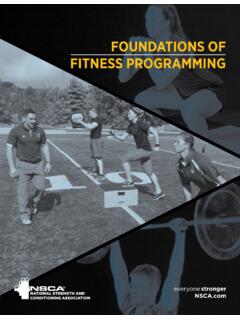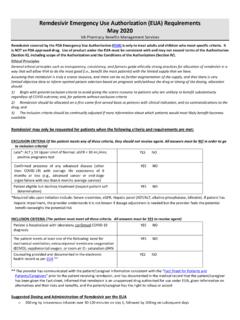Transcription of Stability Analysis with XFLR5
1 Revision Copyright A. Deperrois - November 2010 About Stability Analysis using XFLR5 XFLR5 Revision Copyright A. Deperrois - November 2010 Sign ConventionsThe yaw, such that the nose goes to starboardis >0 The pitching moment nose up is > 0 The roll, such that the starboard wing goes down is > 0 Revision Copyright A. Deperrois - November 2010 The three key points which must not be confused togetherCentre of Gravity CG= Point where the moments act;Depends only on the plane's mass distribution, not its aerodynamicsAlso named XCmRef in XFLR5 , since this is the point about which the pitching moment is calculatedNeutral Point NP = Reference point for which the pitching moment does not depend on the angle of attack Depends only on the plane's external geometryNot exactly intuitive, so let's explore the concept furtherCentre of Pressure CP= Point where the resulting aero force appliesDepends on the model's aerodynamics and on the angle of attack Revision Copyright A.
2 Deperrois - November 2010 The neutral point = Analogy with the wind vaneNPCPWindCGCG forward of the NP The pressure forces drive the vane back in the wind direction Very stable wind vaneCG positioned at the NP The wind vane rotates indefinitely UnstableCG behind the NP The wind vane is in the wrong directionWind vane having undergone a perturbation, no longer in the wind directionThe Neutral Point is the rear limit for the CG2nd principle : Forward of the NP, the CG thou shall positionCG slightly forward of the NP The pressure forces drive the vane back in the wind direction The wind vane is stable, but sensitive to wind gusts Revision Copyright A. Deperrois - November 2010A preliminary note : Equilibrium is not Stability !Both positions are at equilibrium, only one is stableUnstable Stable Revision Copyright A. Deperrois - November 2010 Mechanical stabilityForce FxDisplacementxForce FxDisplacementFx<0Fx<0Fx>0Fx>0 Unstable Stable Revision Copyright A.
3 Deperrois - November 2010 Aerodynamic stabilityAngle of attack Cm (Pitch moment)CGNPU nstable Stable Angle of attack Cm (Pitch moment)Revision Copyright A. Deperrois - November 2010 Understanding the polars Cm = f( ) and Cl = f(Cm) CmNote : Valid only for a whole plane or a flying wingCmClCm = 0 = balance= plane's operating pointNegative slope = StabilityThe curve's slope is also the strength of the stabilizing force High slope = Stable sailplane !For information only :Cm0 = Moment coefficient at zero-liftCm = 0 balanceCl > 0 the model flies !Cm0 Revision Copyright A. Deperrois - November 2010 How to use XFLR5 to find the Neutral Point CmPolar curve for XCG < XNPThe CG is forward of the NPThe plane is stable Cm CmPolar curve for XCG = XNPCm does not depend on The plane is unstablePolar curve for XCG > XNP The CG is behind the NP The plane is wrong wayBy trial and error, find the XCG value which gives the middle curveFor this value, XNP = XCGR evision Copyright A.
4 Deperrois - November 2010 The tail volume (1) : a condition for Stability ?First the definitionLAElev : The elevator's Lever Arm measured at the wing's and elevator's quarter chord pointMAC : The main wing's Mean Aerodynamic ChordAreaWing :The main wing's areaAreaElev :The elevator's area WingWingElevElevAreaMACAreaLATV =LAElevRevision Copyright A. Deperrois - November 2010 Tail Volume (2)Let's write the balance of moments at the wing's quarter chord point, ignoring the elevator's self-pitching momentMWing + LAElev x LiftElev = 0 MWing is the wing's pitching moment around its root chord pointWe develop the formula using Cl and Cm coefficients :q x AreaWing x MACWing CmWing = - LAElev x q x AreaElev x ClElev where q is the dynamic :ElevElevWingWingElevElevWingClTVClAreaM ACAreaLACm = =Revision Copyright A. Deperrois - November 2010 Tail Volume (3)ElevElevWingWingElevElevWingClTVClAre aMACAreaLACm = =The elevator's influence increases with the lever armThe elevator's influence increases with its areaThe elevator has less influence as the main wing grows wider and as its surface increasesWe understand now that the tail volume is a measure of the elevator's capacity to balance the wing's self pitching momentRevision Copyright A.
5 Deperrois - November 2010 Tail Volume (4)ElevElevWingWingElevElevWingClTVClAre aMACAreaLACm = = The formula above tells us only that the higher the TV, the greater the elevator's influence shall be It does not give us any clue about the plane's Stability It tells us nothing on the values and on the signs of Cm and Cl This is a necessary condition, but not sufficient : we need to know more on pitching and lifting coefficients Thus, an adequate value for the tail volume is not a condition sufficient for stabilityRevision Copyright A. Deperrois - November 2010A little more complicated : V-tailsThe angle has a double influence: reduces the surface projected on the horizontal reduces the projection of the lift force on the vertical after a little math:Effective_area = AreaElev x cos The method is borrowed from Master Drela(may the aerodynamic Forces be with him) Projected areaProjected LiftWingWing2 ElevElevAreaMACcosAreaLATV =LiftRevision Copyright A.
6 Deperrois - November 2010 The Static Margin : a useful concept First the definition A positive static margin is synonym of Stability The greater is the static margin, the more stable the sailplane will be We won't say here what levels of static margin are too plenty of publications on the matter also Each user should have his own design practices Knowing the NP position and the targeted SM, the CG position can be XNP - MAC x SM ..without guarantee that this will correspond to a positive lift nor to optimized performancesWingCGNPMACXXSM =Revision Copyright A. Deperrois - November 2010 How to use XFLR5 to position the CG Idea N 1 : the most efficient Forget about XFLR5 Position the CG at 30-35% of the Mean Aero Chord Try soft hand launches in an area with high grass Move progressively the CG backwards until the plane glides normally For a flying wing Start at 15% Set the ailerons up 5 -10 Reduce progressively aileron angle and move the CG backwards Finish off with the dive test Works every time !
7 Revision Copyright A. Deperrois - November 2010 How to use XFLR5 to position the CG Id e N 2 : Trust the program Re-read carefully the disclaimer Find the Neutral Point as explained earlier Move the CG forward from the .. to achieve a slope of Cm = f( ) comparable to that of a model which flies to your satisfaction, or .. to achieve an acceptable static margin Go back to Idea N 1 and perform a few hand launchesRevision Copyright A. Deperrois - November 2010 Summarizing on the 4-graph view of XFLR5 Cl Cm Depending on the CG position, get the balance angle e such that Cm = 0 Check that Cl>0 for = e XCP It is also possible to check that XCP =XCmReffor = e 0 Singularity for the zero-lift angle 0 e e e Cl/Cd e Unfortunately, no reason for the performance to be optimalIterations are required to find the best compromiseRevision Copyright A. Deperrois - November 2010 Consequences of the incidence angle To achieve lift, the wing must have an angle of attack greater than its zero-lift angle This angle of attack is achieved by the balance of wing and elevator lift moments about the CG Three cases are possible Negative lift elevator Neutral elevator Lifting elevator Each case leads to a different balanced angle of attack For French speakers, read Matthieu's great article on Copyright A.
8 Deperrois - November 2010 Elevator Incidence and CG position The elevator may have a positive or negative lift Both configurations are possible The CG will be forward of the wing's CP for an elevator with negative lift "Within the acceptable range of CG position, the glide ratio does not change much" (M. Scherrer 2006)Wing CPCGElev CPWing CPElev CPElevator has a negative incidence vs. the wingElevator has a neutral or slightly negative incidenceNPNPR evision Copyright A. Deperrois - November 2010 The case of Flying Wings No elevator The main wing must achieve its own Stability Two options Self stable foils Negative washout at the wing tipRevision Copyright A. Deperrois - November 2010 Self-Stable Foils The notion is confusing : The concept covers those foils which make a wing self-stable, without the help of a stabilizer Theory and Analysis tell us that a foil's Neutral Point is at distance from the leading edge = 25% x chord But all foils are self-stable ?
9 ?? All that is required is to position the CG forward of the NP What's the difference between a so-called self-stable foil and all of the others ??? Let's explore it with the help of XFLR5 Revision Copyright A. Deperrois - November 2010A classic foilConsider a rectangular wing with uniform chord =100 mm, with a NACA 1410 foil reputedly not self-stableCalculations confirm that the NP is at 25% of the chordUnfortunately, at zero pitching moment, the lift is negative, the wing does not 's the NACA 1410It is usually said of these airfoils that their zero-lift moment coefficient is negativeCm0 < 0 Note : this Analysis can also be done in non-linear conditions with XFoilRevision Copyright A. Deperrois - November 2010A self-stable foilConsider the same rectangular wing with chord 100mm, with an Eppler 186 foil known to be self-stableThe NP is still at 25% of the chordIt would be more intuitive to say "the zero-moment lift is positive" : Cl0 > 0 , the wing flies!
10 Eppler 186It is usually said of these airfoils that "the zero-lift moment is positive", Cm0 > 0which doesn't tell us muchRevision Copyright A. Deperrois - November 2010A more modern way to create a self-stable wingCG The consequence of the negative lift at the tip is that the total lift will be less than with the classic wing Let's check all this with XFLR5 Lift at the rootLift at the tipA classic sailplane wingA flying wing with negative washout at the tipThe positive moment at the tip balances the negative moment at the wing's rootFLift at the rootNegative lift at the tipRevision Copyright A. Deperrois - November 2010 Model dataConsider a simple wing First without washout, Then with -6 washout at tipRevision Copyright A. Deperrois - November 2010 Wing without washoutConsider a static margin = 10%Unfortunately, at zero pitching moment, the lift is negative (Cl<0) : the wing does not flyRevision Copyright A.







